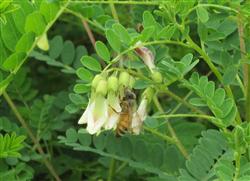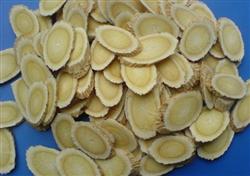How can astragalus be planted with high yield?

How can astragalus be planted with high yield? Please give guidance to astragalus planting to high yield can refer to the following methods: 1, land selection and soil preparation. Astragalus likes cool, resistant to drought, cold and heat, afraid of waterlogging, and avoid high temperature. Its main root grows downward and vertically, so it is better to choose loam with good drainage, sunny and deep soil. Before sowing, combined with the application of agricultural fertilizer 3 000-4000kg, phosphate fertilizer 25-30kg, rake leveling and ridging, ridge width 40-45cm, ridge height 15 cm 20 cm, row spacing 40-45cm. 2. Seed treatment. The seed coat of Astragalus membranaceus is hard and it is not easy to germinate after sowing, so the seed should be treated before sowing. Soak the seeds in 50 ℃ warm water, soak them for 24 hours after the water temperature drops, wash them out and spread them on a wet towel, cover them with a wet cloth to accelerate germination, and sow seeds after the crack mouth emerges. It can also be rubbed with twice as much river sand in the seed, scratch the seed coat, and germinate quickly. Soak the seed 3-5min with 70Mel 80% sulfuric acid, rinse the seed quickly in running water, wash the seed and sow it after a little dry, and the germination rate is more than 90%. 3. Sow seeds. The suitable temperature for seed germination is 14 ℃ 15 min, sowing in spring from March to April, and autumn sowing in the first and middle of October. Strip sowing, open 1.5 cm 2 cm shallow trenches on the ridge surface, spread the seeds evenly into the ditch, cover the seeds tightly with soil. Then irrigate the furrow fields of the two ridges to keep the soil moist. The seedlings will emerge in 15 days. Flat bed planting is also possible, but the disease is more common, and the root shape is not as good as that of ridge planting. Seedling transplanting is commonly used in production. Direct seeding seedlings are planted in spring according to the row spacing of 20 × 40 cm, the ditch depth is 10 cm and 15 cm. The seedlings are placed in the ditch and sown with soil, and about 15000 seedlings are used per mu. 4. the seedlings are fixed in the cultivation and management room. The seedling height of direct seeding 5 cm 7 cm should be determined by time seedling, and the distance between plants should be 10 Mel 15 min. Ploughing and weeding. Ploughing and weeding in time after emergence, and pay attention to cultivate the soil to the ridge, so that the ridge to maintain the original width, generally weeding 2mi 3 times. Top dressing. After the seedlings were fixed, topdressing was carried out, and human and animal manure water 1500kg or urea 5kg was applied per mu, and watered once after application. After weeding in mid-late June, compost 1000kg, phosphate fertilizer 30kg and ammonium sulfate 5kg were mixed on ridges and shallow trenches were applied to cover soil and water. Pest control. The main disease was powdery mildew, which was sprayed with 1000 times of thiophanate methyl. Purple stripe plume disease, damage to the roots, resulting in rotten roots, the plant from top to bottom yellow wilt and finally the whole plant died. The diseased plant should be removed and burned, and the diseased nest should be disinfected with lime powder. At the same time, other pest control should be strengthened. 5. Harvest and processing. The harvest is usually 2-3 years after sowing. It can be harvested from September to November in autumn or before sprouting in winter in spring. Because the main root is deep in the soil, dig carefully and deeply to avoid breaking the main root or bruising the outer skin. After harvest, clean the soil, take advantage of the fresh cut off the Reed head, sun to semi-dry will be directly tied to the root into a handful, and then sun or drying to form raw astragalus. Click to get more planting techniques of Radix Astragali
- Prev

How can Astragalus be cultivated with high yield?
How can Astragalus be cultivated with high yield? Please guide astragalus alias yuan qi, beiqi, a perennial leguminous herb deep roots plants, roots for medicinal purposes, with qi, solid surface, care sore muscle and other functions. Astragalus adaptability is very strong, the general soil can be planted, drought resistance, cold resistance, with deep loose sandy soil for the most appropriate...
- Next

How does Radix Astragali propagate with seeds?
How does Radix Astragali propagate with seeds? Please introduce the seed propagation of Astragalus membranaceus can refer to the following methods: 1. Deal with hard seeds. We must pay attention to this when we cultivate Astragalus membranaceus for the first time. For the hard fruit phenomenon, we need to grind it until the seed coat is not damaged, otherwise it will seriously affect the emergence of seedlings. 2. Sow spring, summer and autumn.
Related
- Fuxing push coffee new agricultural production and marketing class: lack of small-scale processing plants
- Jujube rice field leisure farm deep ploughing Yilan for five years to create a space for organic food and play
- Nongyu Farm-A trial of organic papaya for brave women with advanced technology
- Four points for attention in the prevention and control of diseases and insect pests of edible fungi
- How to add nutrient solution to Edible Fungi
- Is there any good way to control edible fungus mites?
- Open Inoculation Technology of Edible Fungi
- Is there any clever way to use fertilizer for edible fungus in winter?
- What agents are used to kill the pathogens of edible fungi in the mushroom shed?
- Rapid drying of Edible Fungi

